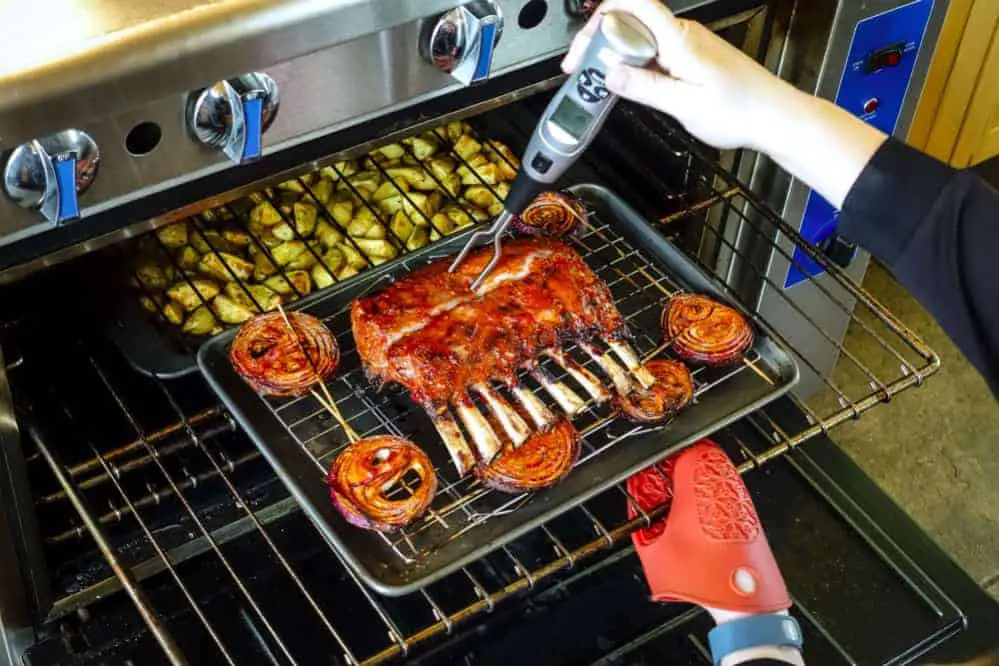This post contains affiliate links. As an Amazon Associate I earn from qualifying purchases
The advent of faster Internet connections and multiple social media outlets have increased the popularity of cooking and devouring steaks, both at home and featured restaurants. In these sites, you would see chefs and cooks using a meat thermometer to check the doneness of the meat. This gives me an excuse to write this article so you can learn how to calibrate a meat thermometer and make it perform consistently.
Of course, cooking great steaks involves more than just checking for the right temperature, it takes patience and guts to temper the tenderness of the meat and to perfect the basic forms of seasoning. It also takes some butchery skills as well as knowledge of meat cuts and how you can prepare them.
Table of Contents
How to Prep the Steak?
When it comes to steak cuts, there are a few ways with which you can enrich the natural flavors that this food has.
Traditional Rub
Most of the time, a simple rub made of salt and pepper is all you need, plus a slather of butter for the gravy and you’re all set.
Steak Aging
Some connoisseurs age their steak cuts to achieve a certain level of tenderness that freshly cut meat doesn’t possess. Meat is aged either through a wet or dry process, but some folks have started doing a hybrid type of aging as well.
- Dry Aging
Dry aging is the process of setting aside unseasoned meat for some days until it forms a moldy crust, together with that funky smell that molds usually come with. The outer layer helps isolate the meat inside, and the microorganisms break down the connective tissue in between the muscle fiber. In effect, this produces a high concentration of flavor as well as the desired tenderness.
Meat for dry aging should be from more expensive cuts as the process requires an even distribution of fat and muscle to be effective. Prime cuts are hung from racks or placed in a shelf under near freezing temperature until the desired age is reached.
Personally, I couldn’t imagine trying this!
- Wet Aging
Wet aging, on the other hand, involves a much simpler process of bagging and tagging meat for consumption. This is the most common form of aging as any cut of meat can be used in this process, and it also takes a lesser amount of time as compared to dry aging.
With this process, meat is placed inside a vacuum-sealed bag to retain the moisture and then kept in near-freezing temperature for about 4-10 days. This method preserves the natural moisture of the meat which in turn enhances the flavor.
Why Use a Meat Thermometer?
Celebrity chefs give tips on how to check if your meat is done or has reached the level of doneness that you like which, in essence, is pure guesswork. The best way to ensure that your meat is really at that level and that any foodborne bacteria has been destroyed is to use a meat thermometer.
Most of the time, meat thermometers are poked into the meat that you are cooking just when you are about to declare it done, maybe a minute or two before you take it out of the pan. These thermometers can either be manual or digital; there’s even an infrared gun meat thermometer, so you don’t have to do any poking.
How to Calibrate a Meat Thermometer?
Knowing how to calibrate a meat thermometer, especially if you like cooking meat on an almost daily basis, is an important skill to learn as it will allow you to produce more consistent results in the kitchen which can give your friends the impression that you know what you’re doing. Not only that but it can protect your health in the long run because if some of your cooking is like mine, you need all the help you can get in cooking meat properly.
However, meat thermometers, like most instruments, tend to degrade in function especially if it has been used a lot.
Most would consider having multiple meat thermometers a good idea since you can just swap one for the other, but this is just a waste of money because you could just end up with several that don’t work properly. Calibrating a meat thermometer is still your best bet in ensuring that your equipment does work when and where you need it.Calibrating a meat thermometer is not a daunting task; it is pretty simple if you know what steps to follow, but before anything else, here are some things you would need:
- Meat Thermometer
- Pot of Water
- Gas or Electric Stove
- Ice Water
- Pliers or Adjustable Wrench
- Bowls
Step 1: Place some water in a pot, and put it on the stove.
Step 2: Allow the water to boil and then turn the heat off.
Step 3: Plunge the thermometer into the hot water and check the temperature.
Step 4: Let it stay in the pot for about 30 seconds.
Step 5: The dial or readout of the meat thermometer should read 100 degrees Celsius or 212 degrees Fahrenheit.
Step 6: Adjust the small nut located at the back of the thermometer to 100 degrees.
Step 7: Wait for the thermometer to cool down a bit and then plunge it again.
Step 8: Repeat the process as needed.
Step 9: Once the heat calibration is done, put some ice into a bowl of water.
Step 10: Plunge the meat thermometer into the coldest part.
Step 11: Let it chill for about 30 seconds.
Step 12: The meat thermometer should read 0 degrees Celsius or 32 degrees Fahrenheit.
Step 13: Adjust the small nut at the back again.
Step 14: Repeat the process as needed.
Things to Take Note Of
- Calibrate meat thermometers once every four to five months, more so if you use it a lot as it does take its toll on the measuring units.
- Take note that if the meat thermometer readout has a variance of around 30 degrees Celsius or 54 degrees Fahrenheit, then it should be replaced as it has gone past calibration.
- Clean your meat thermometers after every use with hot, soapy water. Make sure to wipe it down to remove any remaining grease and food debris.
- Always sanitize the meat thermometer before using it to ensure that any bacteria will be killed and does not transfer into the meat that you are cooking.
Final Thoughts
Meat thermometers and meat preparation go hand in hand with delivering high-quality and well-cooked food, especially if the meat you’re handling is prime cut with great marbling. While meat preparation ensures that the flavors remain true, meat thermometers protect you from food-borne illnesses and ensure that the meat is done to your liking.

